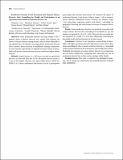Production Diversity Is Not Associated with Women’s Dietary Diversity After Controlling for Wealth and Participation in an Agriculture Intervention in Tanzania

View/
Date
2019-06Author
Guo, Mianzhao
Santoso, Marianne
Bezner-Kerr, Rachel
Kassim, Neema
Martin, Haikael
Mtinda, Elias
Metadata
Show full item recordAbstract
Objectives
Farm production diversity has long thought to be a primary driver of dietary diversity. Few studies have explored the drivers of dietary diversity among women, who are often vulnerable to sub-optimal diets. We therefore investigated how production diversity affects women’s dietary diversity in smallholder farming communities in rural Tanzania. Specifically, we hypothesized that women in households with greater farm production diversity would have higher dietary diversity.
Methods
Female farmers (n = 462) were surveyed on agricultural practices in 2018 and their diet in the subsequent harvest season as a part of the Singida Nutrition and Agroecology Project (SNAP-Tz). SNAP-Tz is a cluster randomized effectiveness trial of a participatory agroecology and nutrition intervention. We estimated the impact of production diversity (crop species richness, range: 1–10) on women’s dietary diversity (Minimum Dietary Diversity for Women, range: 1–10) using linear regression analysis with Stata15, controlling for geographic clustering and other known covariates of women’s dietary diversity.
Results
Farm production diversity was positively associated with women’s dietary diversity after controlling for household size, age, and women’s occupation (b = 0.15, P < 0.01). However, this association was not significant (b = 0.068, P = 0.18) after additionally controlling for household wealth and participation in the intervention.
Conclusions
Contrary to our hypothesis, women living in households with higher production diversity did not have more diverse diets when controlling for other covariates of dietary diversity, i.e., household wealth and participation in the participatory agroecology intervention. Modifiable determinants of women’s dietary diversity are an important area for future exploration. Comparing and contrasting the role of production diversity here to that in other settings will be fruitful.
URI
https://doi.org/10.1093/cdn/nzz034.P10-031-19https://dspace.nm-aist.ac.tz/handle/20.500.12479/2093
